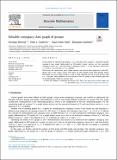Solvable conjugacy class graph of groups
Abstract
In this paper we introduce the graph Γsc(G) associated with a group G, called the solvable conjugacy class graph (abbreviated as SCC-graph), whose vertices are the nontrivial conjugacy classes of G and two distinct conjugacy classes C, D are adjacent if there exist x ∈ C and y ∈ D such that x and y generate a solvable group. We discuss the connectivity, girth, clique number, and several other properties of the SCC-graph. One of our results asserts that there are only finitely many finite groups whose SCC-graph has given clique number d, and we find explicitly the list of such groups with d=2. We pose some problems on the relation of the SCC-graph to the solvable graph and to the NCC-graph, which we cannot solve.
Citation
Bhowal , P , Cameron , P J , Nath , R K & Sambale , B 2023 , ' Solvable conjugacy class graph of groups ' , Discrete Mathematics , vol. 346 , no. 8 , 113467 . https://doi.org/10.1016/j.disc.2023.113467
Publication
Discrete Mathematics
Status
Peer reviewed
ISSN
0012-365XType
Journal article
Description
Funding: The fourth author [BS] is supported by the German Research Foundation (SA 2864/1-2 and SA 2864/3-1).Collections
Items in the St Andrews Research Repository are protected by copyright, with all rights reserved, unless otherwise indicated.

